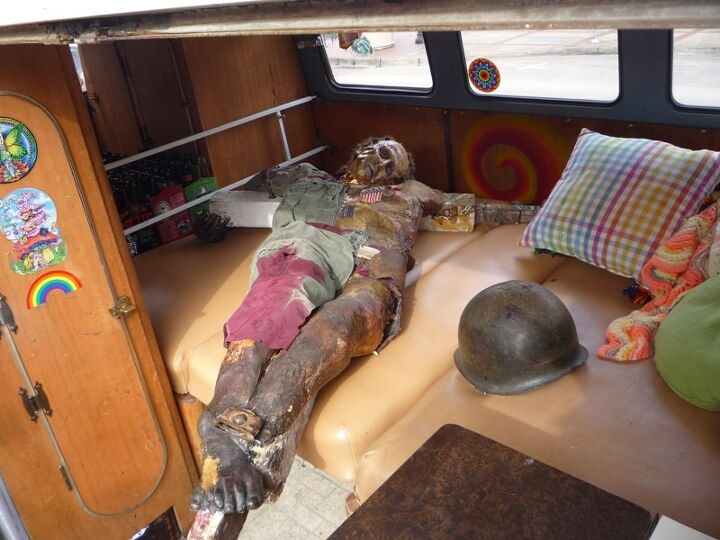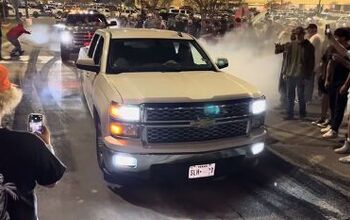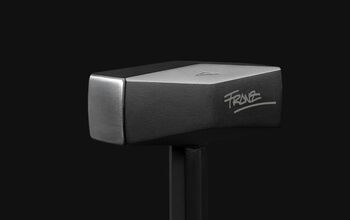Curbside Classic: 1960 VW Bus (Type 2) Westfalia

Welcome to Eugene. Feel free to stay on the bus, either literally or metaphorically. If it’s the former, no hard feelings; Eugene is not for everyone, and we’ll be back in fifteen minutes or so. But if you’re “On The Bus”, then let’s step out here in the center of downtown, also known as Kesey Square. There is the statue of Ken Kesey, Eugene’s hometown cultural and literary hero, reading from his most famous book “One Flew Over The Cuckoo’s Nest”. And what’s that across the street? How serendipitous indeed: a vintage VW bus, the official transporter of Eugene.
Just like it’s usually impossible to identify the absolute source of a new design direction in cars, so it is with cultural trends. But Ken Kesey was something akin to, well, the VW bus. Like the Transporter borrowed heavily from the Beetle, but re-packaged its donor’s mechanicals into a creative and influential new shape, so Kesey borrowed from the Beat era of the fifties and transformed its fading intellectual energy into something new and highly influential. Kesey himself said: “I was too young to be a Beat, and too old to be a hippie”. Perhaps the VW bus could say it was too old to be a Beetle but too young to be a minivan.
The transformation of the Beetle into the Type 2 was the result of an outside agent: the Dutch VW importer Ben Pon. Visiting the factory in 1946 intending to buy Beetles, Pon saw an improvised parts mover (perhaps like this, or not) that inspired him to draw a sketch of a van. With a little time and refinement, VW eventually put the Type 2 into production in 1949, and the world has never been quite the same.
The profound space efficiency of a box with the fundamental characteristics of a passenger car in an economical and well-built package was about as original and revolutionary as it gets in the automobile industry. And its profound adaptability in so many roles make it difficult to pin down exactly what the VW Bus was or wasn’t. But its final and starring role as perhaps the greatest an icon of both practical transport and cultural transformation is undisputed.
Kesey also defies stereotyping. He spent most of his life on the family farm outside of Eugene, married his high school sweetheart (and stayed married to her until his death in 2001), and was a champion high school and college wrestler. He was transformed by an outside agent too: as a volunteer in a CIA-financed study at Stanford in 1959, he was exposed to numerous psychoactive drugs. His book “One Flew Over The Cuckoo’s Nest” was based on his experiences working the night shift at Menlo Park Veteran’s Hospital, often under the influence of LSD or other psychotropics.
His early sixties “Acid Tests” on his rural spread in the Santa Cruz Mts. in the Bay Area were seminal events that spawned a cultural revolution (and the Grateful Dead). And the cross-country trip by the Merry Pranksters in his colorfully painted 1939 International school bus “Furthur” created a legend and was the basis for Tom Wolfe’s “The Electric Kool-Aid Acid Test”. Not everyone may have an intrinsic sense of connection to Kesey or the hippie movement, but its deep and lasting effect can’t be disputed; we’re all eating organic produce, trying to be “green”, and taking yoga classes now. Or should be.
It’s no stretch to say that Furthur is the granddaddy of the whole VW hippie bus phenomena. The VW was the smallest and most economical scale bus with which tens of thousands launched their own personal Electric Kool Aid Acid Tests, generally pointing west, unlike Furthur’s original voyage east to spread the new gospel of the Bay Area. By the late sixties, used and tired VW buses that had played another pioneering role as the first compact van in America were readily available. With a copy of John Muir’s seminal “How to Keep Your Volkswagen Alive: A Manual of Step by Step Procedures for the Compleat Idiot” under the mattress in the back, where seats once ferried little old white haired ladies on outings in the church’s bus.
Those same sturdy pleated seats once ferried me and my family every year to our summer vacation in a village high in the Alps, thanks to the Innsbruck University Hospital’s 1953 “barn door” Kombi Bus, complete with driver. It was very similar to this 1960 Kombi, having just perused the pictures last week. The “barn door” refers to the extra tall rear engine door that also had a shelf for the spare tire above the engine, a feature that was eliminated in about 1955, when the spare migrated to a compartment behind the front seat.
Did I say engine? From today’s perspective, the early VW bus engines simply defy our standards of what that implies. The earliest buses used the 1100cc 24 (net) hp it shared with the Beetle. The key as always was in the gearing: the Type 2 used the reduction gears that hang from the end of the swing axles that the Type 81 Kübelwagen used with great success during WWII. After 1953, the 1200 cc boxer with 36/30 (gross/net) hp powered this and most of the fifties and early sixties Buses. I have vivid memories of watching the ground move by ever so slowly, as the Hospital’s bus worked its way up the final steep pull to Ladis, in second gear. First was just something to get the most heavily loaded bus to overcome the initial inertia, hardly faster than a walking gait. Fourth topped out at about fifty or so, on absolutely level ground.
Not to shoehorn in on Ken Kesey, but it seems like my life and the VW Bus’ are highly intertwined too: My earliest memories are of of black over red buses in Austria in the fifties. In Iowa, German friends of ours with two children took my whole family (of six) on a memorable outing in their Westfalia, and I rode in the compartment over the engine. Much roomier than the little luggage well in the Beetle I used to get dropped into as a toddler. Or did I share it with my brother? Ten people, one Westfalia: previews of coming attractions, squeezed into the bowels of Buses. And loving it.
And then, there was the Smokemobile, a 1965 Bus that a fresh-out-of-college high school teacher who allowed his sophomore class to commandeer for rolling smoke breaks in the neighborhood around Loyola HS in 1968. The Smokemobile was the second car I ever drove, at a rather unusual location: on the grounds of the Maryland School for the Blind, on a Wednesday night, after our community service work there. Next thing I knew, I was driving it all over the place (without a license). Some teachers just don’t know where to draw the line with their students.
One of the odd characteristics of the first generation bus was to watch its rear end lift as it did its facsimile of acceleration, mainly in first gear, just like a BMW motorcycle. An artifact of the reduction gears, it provided a visual counterpoint to the usual rear-end squat of automotive acceleration. It was one of those definitive quirks that added to the Bus’ eccentricity and personality. If you can’t accelerate, you might as well lift up your ass to the world.
Even in our preppy button downs, ties, suits and Weejuns, and having only a faint awareness of Kesey, I knew the the Smokemobile was eminently cool. It primed me for my own departure from Towson, even if that was with the power of the thumb, instead of a Bus. How I wished it were so; achingly so. Actually owning a bus in those days was like having a McMansion in the nineties: instant status within a group that tried so hard to reject that concept.
I won’t bore you with my experience in VW buses during my freewheeling rambling days. But lets just say that when hitchhiking during that period, one’s mood always jumped a bit when that distinctive shape appeared down the road a ways. The odds were mighty high that it would slowly ease over, the double doors would pop open, and welcoming faces from within beckoned. There was always room for one more on the bus. And the whine of the engine and reduction gears were the signal that another adventure was about to begin: “Hey; we’re heading for Big Sur; want to come?”
Forgive my random ramblings, but then that’s what VW buses are all about though. Before we end, I should point out that although the VW bus is the spiritual transporter of Eugene, its presence in the daily streetscape has dropped off considerably. Lousy gas mileage, poor performance, and don’t even ask about its emissions from the few hard core drivers still plying the streets. That’s not to say they’re rare either, and I already had several in the can. But for some reason, I kept holding back. The first CC bus needed context.
So when I finally stumbled upon this one recently on Kesey Square, I knew it was the one. And contrary to stereotypes, it wasn’t driven by an old hippie. I was heartened to see this nice Westfalia camper being driven by a cheerful young woman. Although I shouldn’t have been, I was still a bit surprised when I looked into the rear of her bus: a crucifix, with an effigy mounted to it. Her artist mother made it, and it was being transported, of course. Well, it all makes perfect sense somehow, as long as you’re on the bus.

More by Paul Niedermeyer
Latest Car Reviews
Read moreLatest Product Reviews
Read moreRecent Comments
- Corey Lewis It's not competitive against others in the class, as my review discussed. https://www.thetruthaboutcars.com/cars/chevrolet/rental-review-the-2023-chevrolet-malibu-last-domestic-midsize-standing-44502760
- Turbo Is Black Magic My wife had one of these back in 06, did a ton of work to it… supercharger, full exhaust, full suspension.. it was a blast to drive even though it was still hilariously slow. Great for drive in nights, open the hatch fold the seats flat and just relax.Also this thing is a great example of how far we have come in crash safety even since just 2005… go look at these old crash tests now and I cringe at what a modern electric tank would do to this thing.
- MaintenanceCosts Whenever the topic of the xB comes up…Me: "The style is fun. The combination of the box shape and the aggressive detailing is very JDM."Wife: "Those are ghetto."Me: "They're smaller than a Corolla outside and have the space of a RAV4 inside."Wife: "Those are ghetto."Me: "They're kind of fun to drive with a stick."Wife: "Those are ghetto."It's one of a few cars (including its fellow box, the Ford Flex) on which we will just never see eye to eye.
- Oberkanone The alternative is a more expensive SUV. Yes, it will be missed.
- Ajla I did like this one.










































Comments
Join the conversation
Interesting how a vehicle can bring up such a political debate. I drove a 76 vw van with a poptop from Texas to Utah one summer, the trip stopped short due to some "profiling." I agree with many of the comments above about the naivete and annoyingly smug attitude of the types who drive these as some sort of identity emblem, but hey, you gotta dream, and if you're not dreaming, you should be glad that at least someone is. One saying though that I have yet to be unproven: "Noone is more uptight than a hippy."
I've said it once, and I'll say it again, I kinda understand the grip this bugger has on some American minds, but, but, but...Living where I do, this thing is a constant, in traffic, parked all around you, and it's such a nuisance. even in the land of the 1.0 car, these things are dreadfully slow and inherently danger. Can't wait till in 2012 air bags finally become mandatory and these things finally go the way of the dinosaur. good riddance! if anybody has ever overstaid their welcome...